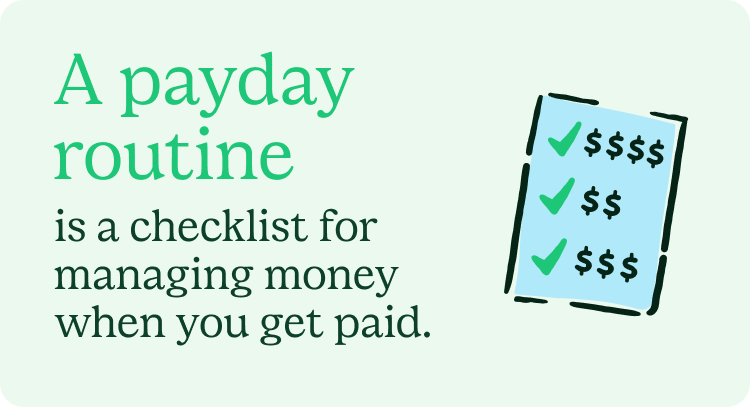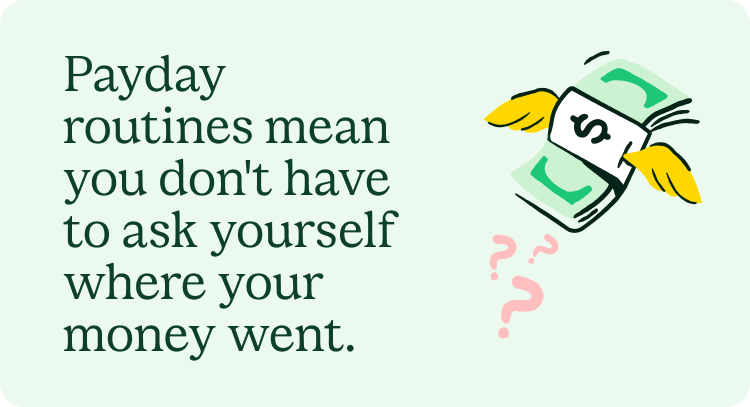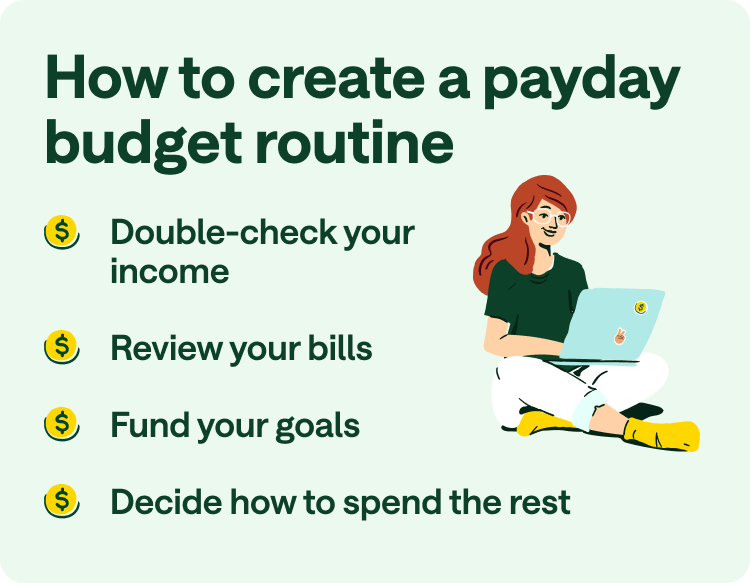Making a budget? Easy. Sticking to it? Not so much.
That’s where a payday budget routine comes in. Having a go-to system for budgeting your paychecks the day they hit your account can help you keep track of every dollar.
Here’s how to make a payday routine that fits your life and fuels your financial goals.
What is a payday budget routine?
A payday routine is a checklist for managing money when you get paid. It’s the series of steps you follow to make sure your bills are paid, expenses are covered, and goals are funded.
You make to-do lists and grocery lists to stay organized – why not take the same approach with your money?
Payday routines can work for anyone because they’re personal – you can mold them to fit your income, bills, and how you get paid. Whether you work a 9-to-5, are self-employed, or do gig work, you can build a payday budget routine.

Benefits of payday budgeting routines
Why should you bother with a payday routine? When you consider the benefits, the answer is pretty clear.
- Ease money anxiety. Consider this: 35% of millennials and 40% of Gen Z say they feel stressed or anxious most of the time.¹ In fact, 42% say they avoid looking at their account balance out of fear. If you feel money stress a payday routine could help calm it.
- Rein in spending. Does it feel like money pulls a vanishing act as soon as it hits your account? Payday routines mean you don’t have to ask yourself where your money went.
- Be intentional. Chances are you’re spending money on things you don’t need. Everybody does it. A payday routine can help you get in tune with your spending patterns and habits and identify what matters most.
- Prioritize your goals. What do you really want to do with your money? Pay off debt? Save for emergencies? Set aside money for a vacation? Whatever your financial goals are, a payday budget routine can help you prioritize them and take actionable steps to reach them.
- Challenge yourself. Sticking to a routine isn’t always easy and it can take several months to successfully build a new habit. Creating a payday routine can help you get into the budgeting habit if it’s something you’ve struggled with in the past.²
Starting a payday routine can take some getting used to. But it’s worth doing if you want to feel better about your money situation.

How to create a budget routine for payday
Ready to put your payday routine together? Here’s how to do it, step by step.
Step 1: Double-check your income
Once your paycheck lands in your account, take a minute to check the amount against your pay stub. Make sure the amounts match up. Review your deductions, including anything you’re putting into a 401(k).
It’s a little trickier if you’re self-employed and have clients or customers who pay you. You may need to verify deposit amounts against invoices or sales records.
Whether you get a regular paycheck or not, the first step is making sure what you expect to get paid matches up with what you receive.
Step 2: Review your bills
Once you know how much money you have to work with, look at what needs to be paid for this pay period, based on how far you are into the month and what’s due.
Say you’re paid biweekly and you get the first paycheck of the month. You might use it to pay:
- Rent or mortgage payments
- Utility bills
- Phone bill
- Internet bill
When your second paycheck comes in you might pay your car insurance, student loans, and credit card bill.
While you’re looking over what needs to be paid, look at whether any of your bills have gone up or down since last month. A bill increase might mean you have to pull money from another budget category to cover it, while a decrease gives you a little extra to work with.
Step 3: Fund your goals
Financial independence and stability are the number one priorities for 46% of 25 to 44-year-olds.³ At the same time, 93% of millennials and Gen Z say they’re concerned about the rising cost of living and how it will impact their ability to get ahead.
Reaching a big goal like financial independence having smaller goals, like:
- Paying off student loans
- Getting rid of credit card debt
- Building an emergency fund
- Saving for retirement
Whatever your goals are, your payday routine should include them. Look at what you have after the bills are paid but before you spend anything to decide how much to send to debt, savings, or investments.
Does it need to be a lot of money? Nope. Even a $5 or $10 transfer to savings makes a difference. This part of your budget routine is about being consistent with funding your goals every single payday.
Step 4: Decide how to spend the rest
Bills are paid and goals are funded, so now it’s time to divvy up what’s left of your paycheck. The simplest approach is to split expenses by needs and wants.
Start with the essentials first. That means things like:
- Gas
- Groceries
- Medical expenses or prescriptions you need
Anything that isn’t a need goes into the second bucket. So, here you might spend money on new clothes, dining out, or travel. This approach encourages you to be mindful about where and how you spend.

Payday routine tips for success
How do you make a payday routine work for you? The simple answer is practice but if you need a few pointers for getting started, these tips can help.
- Put your payday routine on your calendar. Schedule a block of time each payday when you can sit down with your budget to review it and set a notification so you don’t forget.
- Create a calming ritual to go along with your routine. Sit in a comfy spot, make a cup of tea, or listen to soothing music – something that makes the process enjoyable for you.
- Track your progress and celebrate your wins. Did you pay off $100 in debt? Add $50 to savings? Remember that whatever you’re able to do each pay period to get a little closer to your goals counts.
A budget routine can be your best friend when you’re ready to get ahead. Using a budget calculator can simplify the process.

 Log in
Log in
